| Article ID | Journal | Published Year | Pages | File Type |
|---|---|---|---|---|
| 9602683 | Enzyme and Microbial Technology | 2005 | 9 Pages |
Abstract
Degradation of the azo dye Acid Orange 7 (AO7) in batch anaerobic unstirred assays is described. Experiments were carried out: (i) under abiotic conditions, (ii) with active biomass using only the dye as organic substrate, and (iii) with the dye and different cosubstrates. Non-adapted biomass was used. The results obtained indicate that AO7 was only removed in the presence of active biomass, the removal rates being higher in the presence of a cosubstrate. The highest removal rates were obtained with a high concentration of glucose, 2 g lâ1, which indicates that apart from the positive influence of the presence of an excess of reducing equivalents, the improvement of mass transfer conditions in the medium as a consequence of the high biogas production is also a key topic. AO7 yields sulphanilic acid (SA), which was not further degraded and was accumulated in the medium in stoichometric amounts. The other compound resulting from AO7 breakdown, 1-amino-2-naphthol (1A2N), was not detected most likely because of its low stability. However, the detection of 1,2-naphthoquinone (12NQ), a compound generated after the oxidation of 1A2N gives evidence of this mechanism.
Related Topics
Physical Sciences and Engineering
Chemical Engineering
Bioengineering
Authors
D. Méndez-Paz, F. Omil, J.M. Lema,
